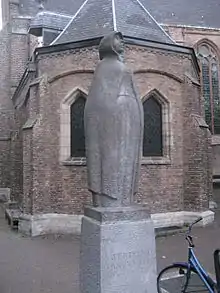Gertrude van der Oosten
Gertrude van der Oosten (or Gertrude of Delft; died 6 January 1358) was a Dutch Beguine who was considered a mystic and had received the Stigmata.

Life
Gertrude was born in Voorburcht in the County of Holland, to peasant parents, and entered domestic service at Delft. Her surname of van Ooten, or "of the East", came from her custom of singing a hymn which began: Het daghet in den Oosten, i.e., "Daylight breaks in the East", which she is thought to have composed herself.
After living a pious life for many years and being jilted by her fiancé,[1] Gertrude obtained admission into the beguinage in Delft. Here, though not a nun, or bound by religious vows, she profited by the ample opportunities for contemplation afforded by life in this community. She had great devotion to the mysteries of the Incarnation, especially to the Passion of Christ. She is believed to have received the Stigmata in the Good Friday of the year 1340:[1] "while she lay prostrate before a crucifix, red blood began to gush from her hands, feet, and side and continued to do so seven times that day for every canonical hour, and for days after."[2] She begged God that this grace might be withdrawn, and her prayer was granted to the degree that the blood ceased to flow, but the marks of the Stigmata remained.[2] At the same time she displayed the gift of prophecy.
According to the hagiography, her breast became filled with milk when she meditated on the Nativity of Jesus.[3]
Gertrude died in Delft on the feast day of the Epiphany and was buried in the Church of St. Hippolytus in Delft, as that beguinage did not have its own church or cemetery. Her name has never been inscribed in the Roman Martyrology, though she is commemorated in various others, and her cultus is a purely local one.
References
- Elina Gertsman (July 5, 2017). Visualizing Medieval Performance: "Perspectives, Histories, Contexts ". Routledge. p. 133. ISBN 9781351537377.
- Carolyn Muessig (February 6, 2020). The Stigmata in Medieval and Early Modern Europe. Oxford University Press. p. 130. ISBN 9780198795643.
- Elena Ene D-Vasilescu (2018). Heavenly Sustenance in Patristic Texts and Byzantine Iconography Nourished by the Word. Springer International Publishing. p. 40. ISBN 9783319989860.
- Attribution
 This article incorporates text from a publication now in the public domain: Herbermann, Charles, ed. (1913). "Ven. Gertrude van der Oosten". Catholic Encyclopedia. New York: Robert Appleton Company.
This article incorporates text from a publication now in the public domain: Herbermann, Charles, ed. (1913). "Ven. Gertrude van der Oosten". Catholic Encyclopedia. New York: Robert Appleton Company.